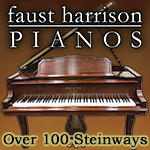I admired this pianist. Here's an excellent review of his life and career by the former music critic of the NY Times, Allan Kozinn:
Byron Janis, Pianist of Romantic Passion, Dies at 95
He had a brilliant career before arthritis in his hands forced him from the stage, but he overcame the condition and returned to performing.
By Allan Kozinn
March 17, 2024
Byron Janis, an American pianist renowned for his commanding performances of the Romantic repertory and for his discovery of manuscript copies of two Chopin waltzes, died on Thursday in Manhattan. He was 95.
His death, at a hospital, was confirmed by his wife, Maria Cooper Janis. He remained active, writing about his career and managing recordings of his music, until recent days, she said.
On the concert stage, Mr. Janis could seem like a tightly wound spring, full of tension that, when combined with the sheer physical energy he brought to his performances, yielded interpretations that could be overpowering and seductive, by turns.
At the height of his career, in the 1950s and 1960s, he was known for the tremendous sound and colorful sonorities he drew from the piano, and for a freewheeling interpretive approach that sometimes led him to bypass composers’ expressive markings when they were at odds with his conception.
“Mr. Janis has a quirky physical style compounded of nervous hovering, sudden jabs, bounces, brittle taps and tentative caresses,” the critic Will Crutchfield wrote in The New York Times, reviewing a recital at the 92nd Street Y in 1985. “The music emerges a little like that too; occasionally it’s disconcerting, but at least he has a style, and more often it is engaging.”
What audiences did not know was that by the early 1970s, Mr. Janis was experiencing pain and stiffness during his performances, the result of psoriatic arthritis in both hands and wrists. After he was diagnosed, in 1973, he maintained his concert schedule, and his five-hour daily practice regimen.
He did not begin speaking about his arthritis until 1985, when Nancy Reagan announced his appointment as National Ambassador to the Arts for the Arthritis Foundation after a recital at the White House. He also became involved with the Juvenile Arthritis Conference.
But continued deterioration of his joints, particularly that of his left thumb, made even touching the keyboard excruciating. When surgery, in 1990, left the thumb slightly shorter but enough to exact a cost in his ability to execute some of the stretches required in big Romantic showpieces, he went into a depression.
“When I took the bandages off, I thought ‘Oh, my God,” he told The Times in 1997. “I had overcome many things, but I thought I would never play again, not even for myself. I didn’t want to see or talk to anybody. I tried to think positively, but I couldn’t.”
Mr. Janis withdrew from the concert stage — temporarily, as it turned out — and devoted himself to songwriting, a pastime of his youth that he had given up when his touring schedule became too demanding.
With the encouragement of the folk singer Judy Collins, he sent a tape of his songs to Warner Chappell, the music publisher, which engaged him to compose 22 songs for a theatrical setting of “The Hunchback of Notre Dame,” with lyrics by Hal Hackady and a book by Anthony Scully. The show had its premiere at the Westbeth Theater, in Manhattan, in 1993.
Also among Mr. Janis’s works was an incidental score for “Cooper and Hemingway: The True Gen,” a 2013 documentary about the relationship between Ernest Hemingway and Mr. Janis’s father-in-law, the actor Gary Cooper. Mr. Janis and Maria Cooper married in 1966. An earlier marriage, to June Dickson Wright, ended in divorce. Mr. Janis had one son, from his first marriage, Stefan, who died in 2017.
In the mid-1990s, Mr. Janis returned to performing, gingerly at first, giving short performances at benefit concerts, at which he shared the bill with other performers, and working his way up to a program of works by Mozart, Schumann, Chopin and Prokofiev for an Alice Tully Hall recital in 1998 that commemorated the 50th anniversary of his Carnegie Hall recital debut.
Born Byron Yanks in McKeesport, Pa., on March 24, 1928, he grew up in Pittsburgh, where his father, Samuel, owned a sporting goods store. The elder Mr. Yanks had changed the family name from Yankilevitch before his son was born, and he would change it twice more — to Jannes and, finally, Janis — by 1943.
Mr. Janis’s mother, Hattie, was a homemaker. She first noticed her son’s musical talent when he was given a xylophone, around age 5, and quickly began picking out melodies. When he began correcting mistakes his older sister Thelma made while practicing for her piano lessons, Mr. Janis’s parents allowed him to have lessons of his own.
His first teacher, Abraham Litow, was impressed enough with Mr. Janis to bring him to New York to play for the virtuoso pianists Josef and Rosina Lhevinne. When he was 7, Mr. Janis, accompanied by his mother, moved to New York to study with the Lhevinnes and their assistant, Adele Marcus, at the Chatham Square Music School.
Early in 1944, when he was 15, he made his orchestral debut, performing the Rachmaninoff Second Concerto with the NBC Symphony Orchestra. He played the same work with the Pittsburgh Symphony Orchestra that February. Lorin Maazel, who was then 14, conducted.
Those performances brought him to the attention of Vladimir Horowitz, who agreed to teach Mr. Janis for three years, provided that Mr. Janis studied with him exclusively, and that he agreed not to mirror Horowitz’s style. “You want to be a first Janis,” Mr. Janis quoted Horowitz telling him, “not a second Horowitz.”
During his time under Horowitz’s tutelage, Mr. Janis resisted pressure from his manager to present a New York recital debut, arguing that he wanted to gain experience performing in other cities in the United States.
But after a successful tour of South America, he decided the time was right, and on Oct. 29, 1948, he made his Carnegie Hall debut, playing works by Bach, Beethoven, Schubert, Mendelssohn, Chopin, Liszt, Scriabin and Prokofiev. Olin Downes wrote in The Times that “not for a long time had this writer heard such a talent allied with musicianship, the feeling, the intelligence and artistic balance shown by the 20-year old pianist.”
Mr. Janis was already recording for RCA Victor Records by then, having signed with the label when he was 18. He also recorded for Mercury, Philips and EMI; his Chopin and Rachmaninoff recordings, which have been reissued several times, are particularly prized.
In concert, he was at his best in works that demanded a huge, muscular sound and a persuasive emotional underpinning, like the Tchaikovsky and Rachmaninoff concertos and the works of Liszt.
In 1960, he toured the Soviet Union as part of the first cultural exchange program between the two countries. After a chilly opening night reception in Moscow — the tour took place shortly after the Soviets shot down an American spy plane — Mr. Janis’s performances of the Rachmaninoff Concerto No. 3 and Gershwin’s Concerto in F drew frantically cheering and sometimes tearful audiences.
Mr. Janis did not shy away from controversy. When he was roughed up by a policeman in Villefranche, on the French Riviera, in 1963 — the officer said that Mr. Janis and his friends were singing too loudly at an outdoor cafe — he demanded, and received, an apology from the French minister of the interior. And in 1965, he canceled a concert in Mobile, Ala., in protest of Gov. George Wallace’s brutal suppression of civil rights protests.
Mr. Janis and his wife lived in the same apartment on the Upper East Side of Manhattan, with two pianos in the living room, since 1968. She is his only immediate survivor.
In 1967, while visiting the Château de Thoiry, in Yvelines, France, Janis was shown a pair of manuscripts that the owner, Count Paul de la Panouse, found in a box marked “old clothes.”
Mr. Janis identified them as manuscript versions, in Chopin’s hand, of the Waltz in G-flat (Op. 70, No. 1) and the Grand Vals Brilliant in E flat (Op. 18). Both were well-known works, but the manuscripts included variant details.
Strangely, lightning struck twice: two years later, Mr. Janis found different Chopin manuscripts of the same two works in an uncataloged collection at Yale University. He published these finds in a book, “The Most Dramatic Musical Discovery of the Age,” in 1978.
Mr. Janis began teaching in 1962, and joined the faculty of the Manhattan School of Music in 1987. Above all, in his teaching, he encouraged independent thought.
“Talented students must be taught that they are not only pianists but artists, and to create, not imitate,” he wrote in a 2016 essay in The Wall Street Journal. “They should be shown that inspiration comes from living, experiencing and observing life, the real as well as the imagined.”











